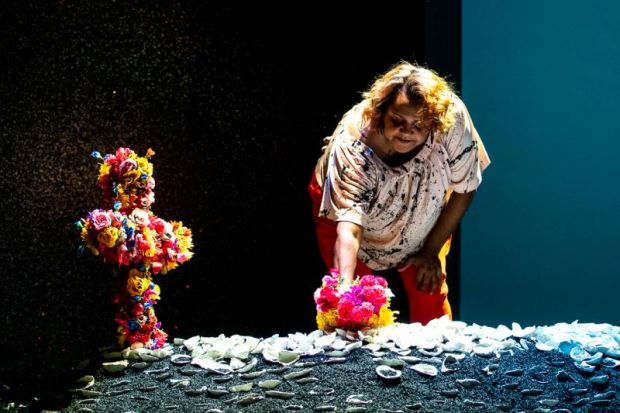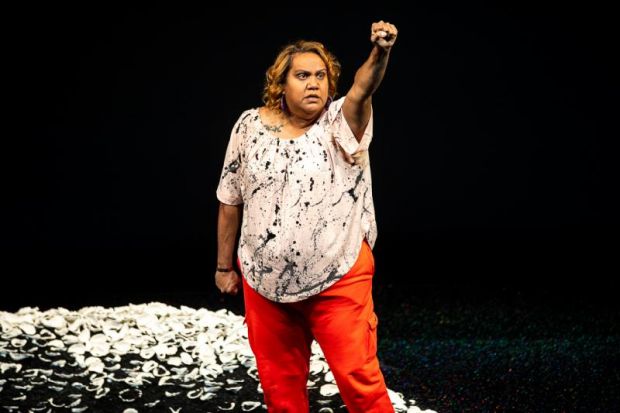The 7 Stages of Grieving
“You can’t go back”, the Woman says in the final moments of 7 Stages of Grieving.
Yet Sydney Theatre Company has gone back mount a fourth production. What is it about this play that makes a company “go back” to it again, and again? STC Artistic Director Kip Williams explains some of the reasons:
“It is a formally revolutionary landmark of Aboriginal theatre.”
“It has left an indelible mark on the arts landscape.”
“It is chillingly effective and powerfully radical.”
“It … continues to resonate with such urgency.”
“One performer taking the time and space to tell the story of First Nation Resistance.”

That one performer is a woman, a “sole, Blak performer: going deep into grief every night and handing it over to a majority non-Blakfulla audience” writes director Shari Sebbens. She acknowledges the enormous emotional weight this puts on the performer. The stories she tells are distressing. The way she tells them varies. She must move from pathos to humour. From storyteller to stand-up comic. From raconteur to reading a police report. She must be strong, fierce, passionate, touching, real. She must, in fact, be … “deadly”!
Sebbens found all those qualities in Elaine Crombie: actor, dancer, singer with experience across stage, screen and television. Someone who could adapt, improvise, and engage.

Crombie plays ‘The Woman’ with courage, compassion, deep empathy, and her own deadly sense of humour! She identifies strongly with each ‘stage’ of grief, each compelling message. She finds every nuance of sadness and celebration in the story of “Nana’s” funeral: the solidarity of the family, the reactions of the white neighbours, the distress of putting her grandmother’s photo away. She swings into a practised and fast paced stand-up routine to perform the very satirical “Have You Ever Been Black?” She describes the silent march in Brisbane against police brutality with controlled restraint.
Every message in this play is important – and very sensitive. Striking the balance between performing and identifying with the stories isn’t easy. Fortunately, Wesley Enoch and Deborah Mailman managed to find that balance in their writing. Every ‘stage of grief’ they describe is a strong statement – but they don’t preach! They share. They inform. They explain. They ask for change. Yet in the 26 years since 7 Stages of Grieving was first performed, so little has changed.

That’s why this play is still being performed. Why its messages are still so relevant. What foresight Enoch and Mailman had to write it in a form that could be adapted and revisualized … as Shari Sebbens and designer Elizabeth Gadsby have done in this production.
Gadsby has symbolised indigenous history with a series of middens covered with shells. One becomes a grave that Crombie establishes with a cross of brilliantly coloured flowers that tinkles as she puts it in place. The brightness of the flowers reflects the bright colours in which Crombie dressed, the glitter on her shirt another symbol which Sebbens describes as “a sparkling reflection of Blak joy amongst the grief”.
A huge screen is used as a creative – and compelling – backdrop. On are projected the many words associated with grief that introduce the play … and later the dates of 475 black deaths in custody… and even later a list of “7 Actions of Healing” that bring the play right into the present. During “Nana’s Story” the Words of “Delta Dawn’ are projected so the audience can sing along!

As Crombie grabs a microphone from stage left to begin “Have You Ever Been Black?” a red curtain drops suddenly to transform the scene, then disappears just as suddenly as that ‘stage’ in the story finishes.
Sebbens and Gadsby have used innovative ideas to highlight the sensitive messages that Crombie performs so perceptively. 7 Stages of Grieving will continue to be performed whilst ever the changes it asks for still need to be made. As Shari Sebbens sees it …
To me this play feels eternal
which makes me happy.
But also, this play feels eternal,
and that makes me furious.

Review: Carol Wimmer
Photographer: Joseph Mayers
Subscribe to our E-Newsletter, buy our latest print edition or find a Performing Arts book at Book Nook.

